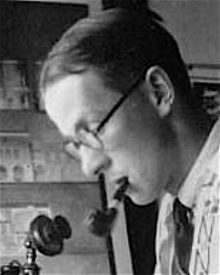
Charles Holloway James [commonly known as C.H. James] was born in Gloucester, Gloucestershire, England, on 22 January 1893 and was articled to Walter B. Wood in Gloucester. He then worked as assistant to Sir Edwin Lutyens from 1911 to 1914.
In 1916 he was seriously injured and lost a leg during World War One. For a short time he worked for Barry Parker and Raymond Unwin at Letchworth Garden City, before commencing practise as an architect in London in 1919. In 1919, with Albert John Thompson (1878-1940) and Charles Murray Hennell (1883-1929) he formed the London-based architectural partnership Thomson, Hennell & James. Thompson left the practice the following year and the practice was renamed Hennell & James.
The first architectural projects by James and his practice were large housing schemes. These included Swanpool Garden Suburb in Lincoln (1919-21); 27 houses at Thorpe Bay in Essex (1920-21); 80 houses for Labour Saving Houses, Ltd.; 200 houses for Wewlyn Rural District Council; and 38 houses for Country Homes, Ltd., at Welwyn Garden City, (1920-25); and 92 houses for the Lady Aster Housing Trust, Plymouth (1925). They also designed a paint factory in Hull (1920-21).
James designed three houses for himself in Hampstead Garden Suburb, beginning with No. 1 Hampstead Way in 1920.
After Hennell's death in 1929, James formed a new partnership with Stuart Frank Bywaters as James & Bywaters. They were subsequently joined by Stephen Rowland Pierce (1896-1966) and the practice was renamed James & Bywaters and Rowland Pierce. Projects by the partnership included Slough Town Hall (1936), City Hall in Norwich (1938), and Hertford County Hall (1940). The partnership was dissolved in 1947. It would seem that the practice reverted to its original name, James & Bywaters. This name was retained until 1963 when it became Saunders Boston Architects.
In addition to Thompson, Hennell, Bywaters and Pierce, James collaborated with a number of other architects including Louis de Soissons (1890-1962) at Welwyn. He jointly designed Oakwood Station with Charles Holden (1875-1960) on the Piccadilly Line (1933).
In 1922 James married the designer Margaret Calkin (1895-1985), subsequently known as Margaret Calkin James.
James was elected an Associate of the Royal Institute of British Architects (ARIBA) in 1918 and a Fellow of the Royal Institute of British architects (FRIBA) in 1926. He was vice-president of the Royal Institute of British Architects in 1947-48. He was elected an Associate of the Royal Academy (ARA) in 1937 and a Royal Academician (RA) in 1946.
James's address was given as 19 Russell Square, Bloomsbury, London in 1919 and 1923; 15 Gower Street, London in 1926; 33 Bedford Place, Bloomsbury Square, London in 1930; and 5 Bloomsbury Street, London in 1935 and 1939. He died in Hendon, Middlesex on 8 February 1953.
Swanpool Garden Suburb, Lincoln, 1919-21; 27 houses at Thorpe Bay, Essex, 1920-21; paint factory, Hull, 1920-21; 80 houses for Labour Saving Houses, Ltd., 200 for the Wewlyn R.D.C., and 38 for Country Homes, Ltd., all at Welwyn Garden City, 1920-25; 92 houses for the Lady Aster Housing Trust, Plymouth, 1925; almshouses near Grimsby, 1925; many larger houses In various localities, including five at Hampstead Garden Suburb. James was also consulting Architect to the County Borough of Stoke-on-Trent for five housing schemes
Darling, Elizabeth. ‘Kensal House: the Housing Consultant and the Housed’ in British Architecture and Design in the 1930s. Edited Suannah Charlton, Elain Harwood and Alan Powers. The Journal of the Twentieth Century Society, no. 8, 2007 pp.106-116
Marriott, Basil. ‘Charles Holloway James’. Architectural Association Journal vol. 68, April 1953 pp. 175-176
Marriott, Charles. Modern English Architecture. London: Chapman & Hall, 1924
'Obituary'. The Architects’ Journal vol. 117, 12 February 1953 p. 214
'Obituary'. The Architects’ Journal vol. 117, 19 February 1953 p. 235
'Obituary'. The Builder vol. 184, 13 February 1953 p. 264
'Obituary'. Royal Institute of British Architects Journal vol. 60, March 1953 p. 206
'Obituary'. Town and Country Planning vol. 21, April 1953 p. 182
Phillips, Randal. 'An architect's own house, Hornbeams, Hampshire'. Country Life vol. 86, 5 August 1939 pp. 124-125
Who's Who in Architecture 1923. Edited by Frederick Chatterton. London: Architectural Press, 1923